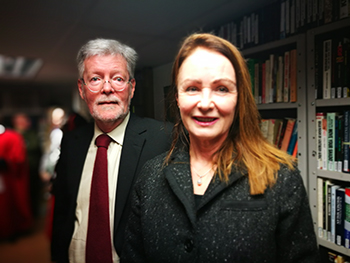Top PhD graduates hailed for excellent research in development and historical studies

Prof Melanie Walker and Prof Ian Phimister
The Centre for Research on Higher Education and Development and the International Studies Group celebrated its PhD graduates on 26 June 2017. The four graduates were joined by their PhD promoters Prof Ian Phimister and Prof Melanie Walker, the Dean of the Faculty of Economic and Management Sciences, and their families, who came from far and wide, as well as various faculty academics and staff. Their areas of study ranged between Development Studies and Africa Studies, exploring issues that make a significant impact on the Southern African region and the continent as a whole.
In the Faculty of Economic and Management Sciences, specialising in Development Studies, Dr Faith Mkwananzi, promoted by Prof Merridy Wilson-Strydom, explored the lives and educational aspirations of marginalised migrant youth, a case study in Johannesburg. She focused on the complex nature of the daily lives and experiences of marginalised migrant youth and the complexities that influence the formation and achievement of educational aspirations in contexts of vulnerability and disadvantage. The study provides compelling evidence for policy and practice that can make the lives of marginalised young migrants better.
A focus on teaching and learning in Zimbabwean universities with a focus on quality as a human development, was what Dr Patience Mukwambo, put her research efforts into. Her work makes an original contribution to national, continental, and international debates on conceptualising and operationalising the quality of teaching and learning in higher education. She successfully developed a significant alternative approach to understanding what quality in higher education teaching and learning entails, the factors that influence the realisation of quality as she theorises it, and the overall importance for human development and human well-being in universities and society.
Dr Bothwell Manyonga, who also specialised in Development Studies, examined the broader debates on the purposes and practices of teaching and learning in higher education with a case study at two South African universities, with an emphasis on principles of social justice and equity. In the thesis, he developed a model that proposes grounds for (re)thinking sociology teaching and learning to address how the capabilities approach and dominant human capital theory might complement each other in higher education and curriculum development. This takes into account both the instrumental aim of employment, which is of concern to students, as well as the intrinsic goods of critical discourse and personal development.
In the Faculty of the Humanities, with a specialisation in Africa Studies, Dr Abraham Mlombo’s doctoral research explored the relationship between Southern Rhodesia and South Africa 1923-1953, examining the ‘special relationship’ between the two countries from the former’s perspective, highlighting the complexity of the ties between them by examining (high) political relations, economic links and social and cultural ties. “It is through Abraham’s research that for the first time, black experiences of both sides of the colonial border are detailed,” said Prof Phimister.
In congratulating the graduates, Prof Melanie Walker expressed that a lot of hard work was put into training the PhD candidates and they had without a doubt produced work that was of the highest level, at international standards.